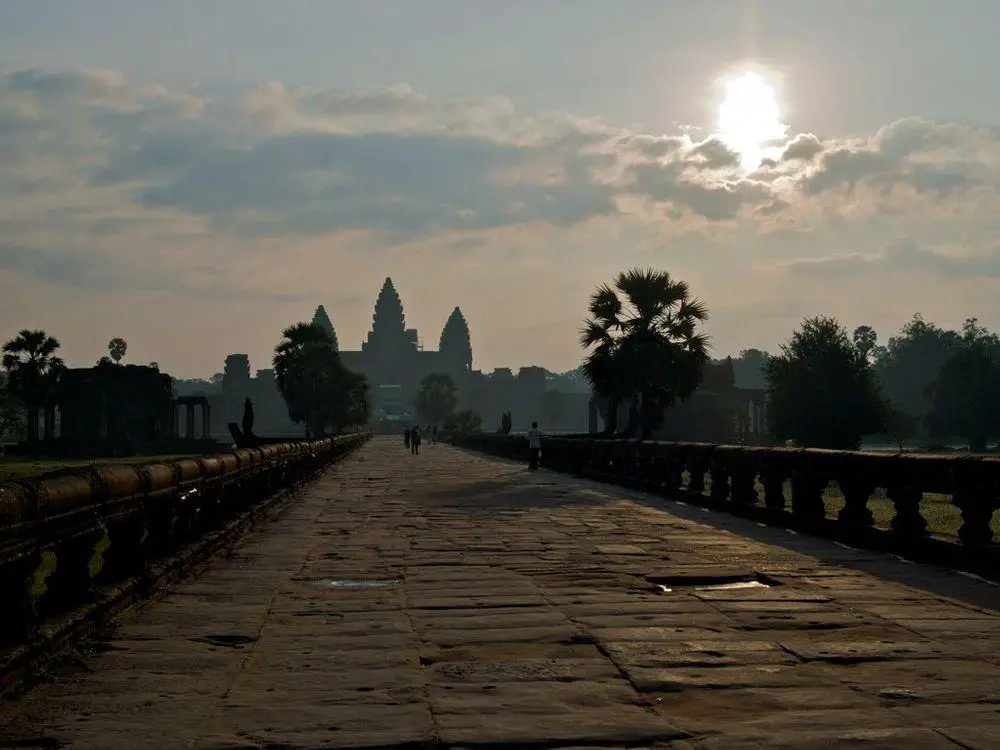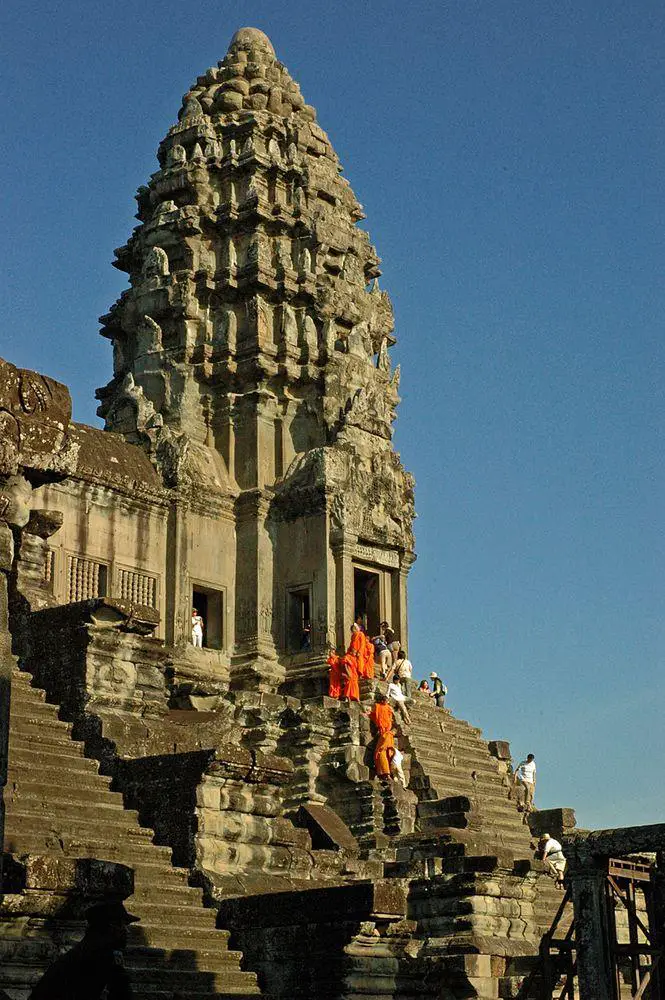Hindu shrines 🢔 Religious architecture 🢔 Archaeological wonders 🢔 Categories of wonders
Wonder
Angkor Wat
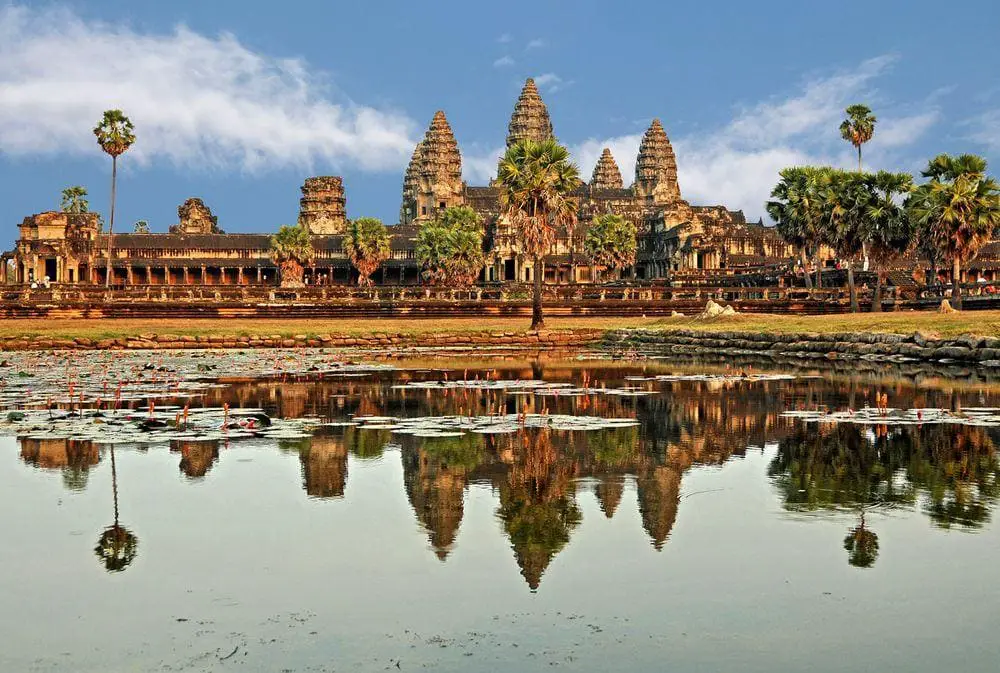
 In short
In short
The largest religious monument in the world is Angkor Wat. This gorgeous temple complex was constructed in the first half of the 12th century and is not just the highest achievement of Khmer architects: it is one of the highest achievements in the history of world architecture.
 76.0%
76.0%
GPS coordinates
Writing in Khmer
Alternate names
Age
Religion
UNESCO World Heritage status
Map of the site
If you see this after your page is loaded completely, leafletJS files are missing.
 In detail
In detail
Description
Concentric planning
Planning of Angkor Wat unites two major principles of Khmer architecture – the principle of the temple-mountain and galleried temple.
When looking from above Angkor Wat represents a giant rectangle. It is surrounded by 190 m wide moat and its area (including the area of the moat) is almost 200 hectares.
This moat is crossed by earth bank in the east and causeway (possible replacement to wooden bridge) in the west. On the "island" at each entrance are ruins of gopuras – ornate entrance gates.
The temple has concentric planning. The rectangular island is surrounded by 1,024 m by 802 m large (3.6 km long) and 4.5 m high wall which encloses 820 thousand m² large area.
Most of the area on this island once was covered with secular buildings, including the former royal palace. Nothing remains of these buildings – these structures were made mainly from wood.
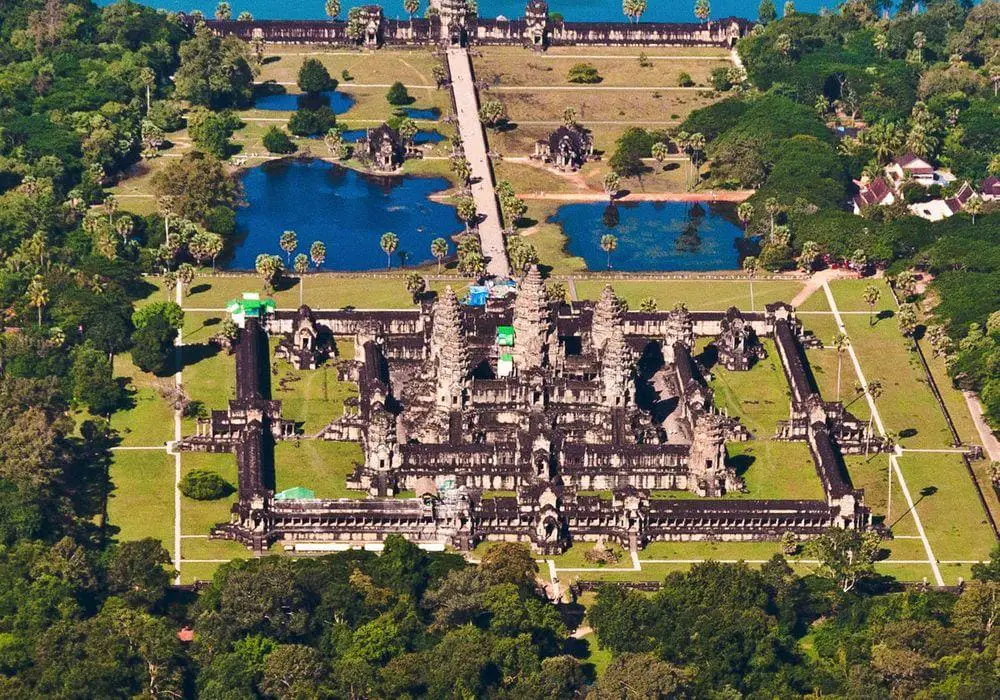
In the middle of this large enclosure is considerably smaller (but nevertheless giant) central temple structure which consists of three concentric galleries divided by walls. Outer wall of this central structure is 187 by 215 m large and whole structure is rised above the surrounding city.
Each next level of the temple was progressively more exclusive. Common people could access only the lower level.
Next enclosure is 100 by 115 m large and the inner enclosure (named Bakan) is 60 by 60 m large.
Inner enclosure contains five impressive towers, the tallest is the central one which rises 43 m tall about its fundament and 65 m above the ground level outside the temple.
Religious symbolism
These main towers symbolize the five summits of Mount Meru, the abode of devas.
Angkor Wat is dedicated to Vishnu thus breaking the earlier Shaivism tradition of Khmer religious culture.
Temple is oriented towards the west what is unusual for Khmer architecture. Some scholars of Eastern architecture consider that this is a hint that Suryavarman II built this structure as his funerary temple. Some other scholars though consider that this westward orientation is typical for Vishnaite temples – Vishnu is associated with the west.
Immense art values
Total amount of sandstone (more than 5 million tons) used for construction is similar to the volume of the Khafre’s pyramid in Egypt with the exception that in Angkor Wat most stones have been sculpted and covered with timeless artworks.
Especially numerous and diverse are bas-reliefs which cover more than 1,000 m². Imagine – one thousand square meters of artwork!
Most bas-reliefs cover the back wall of the outer enclosure – they were located in the zone which was accessible for the general public. Most friezes show episodes from the Hindu epics of Ramayana and Mahabharata and are made in the highest quality. Especially beautiful work of art is scene "Churning of the Sea of Milk". It shows 92 asuras (a kind of anti-gods) and 88 devas (deities) churning the sea with the serpent Vasuki. Their intent is to get from the Sea of Milk (mythical cosmic sea) the nectar of immortality with the assistance of the helpful Vasuki. Asuras, devas, and Vasuki churned the sea for a thousand years. Devas managed to get the nectar and now are immortal. Each figurine has its specific features – haircut, garments, jewelry, and most likely these bas-reliefs show the actual fashion in Angkor in these times.
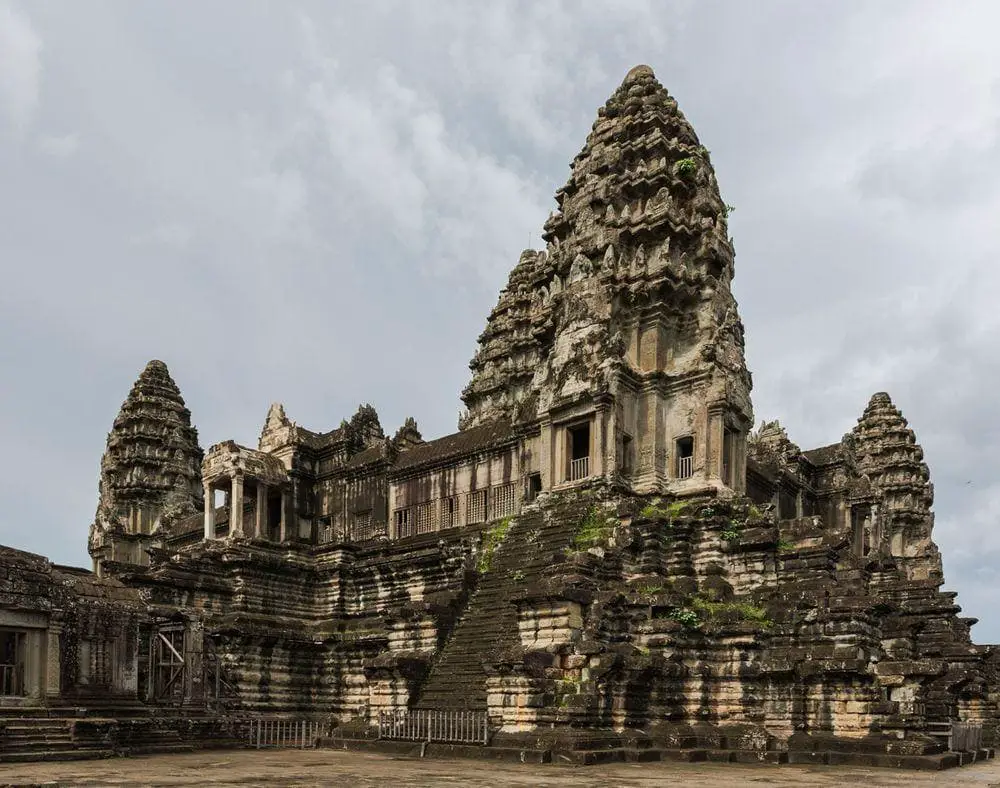
Contemporary visitors are stunned by the beautiful architecture of this structure but in earlier times it was much more impressive: towers were adorned with gilded stucco, many figures were covered with gold as well. Unfortunately, Angkor Wat, like most of the other architectural landmarks in Cambodia, has been heavily looted.
History
Khmer Empire
It is assumed that with the present-day technologies the construction of Angkor Wat would take 300 years. But, nevertheless, it was actually built in 40 years. It was possible due to well established cultural traditions of the Khmer Empire, including the unique skills acquired by stone carvers over several centuries.
Angkor
Khmer Empire evolved since the early 9th century and its most important city was Angkor (this word in Khmer means – "city") which served as the capital of Khmer Empire in the 9th – 15th century.
Angkor is one of the most impressive ancient, abandoned cities in the world. It’s area with all the suburbs exceeded 1,000 km².
Most likely this was one of the most beautiful cities in the world history with a large collection of outstanding buildings.
Angkor in its golden times was developing very fast and almost every king built his own main temple of the city, trying to surpass the impressiveness of the previous one. Thus were created such wonders of Khmer architecture as Ta Keo, Phimeanakas, Baphuon.
Suryavarman II
One of the greatest personalities in Khmer history is king Suryavarman II who reigned in the first half of the 12th century.
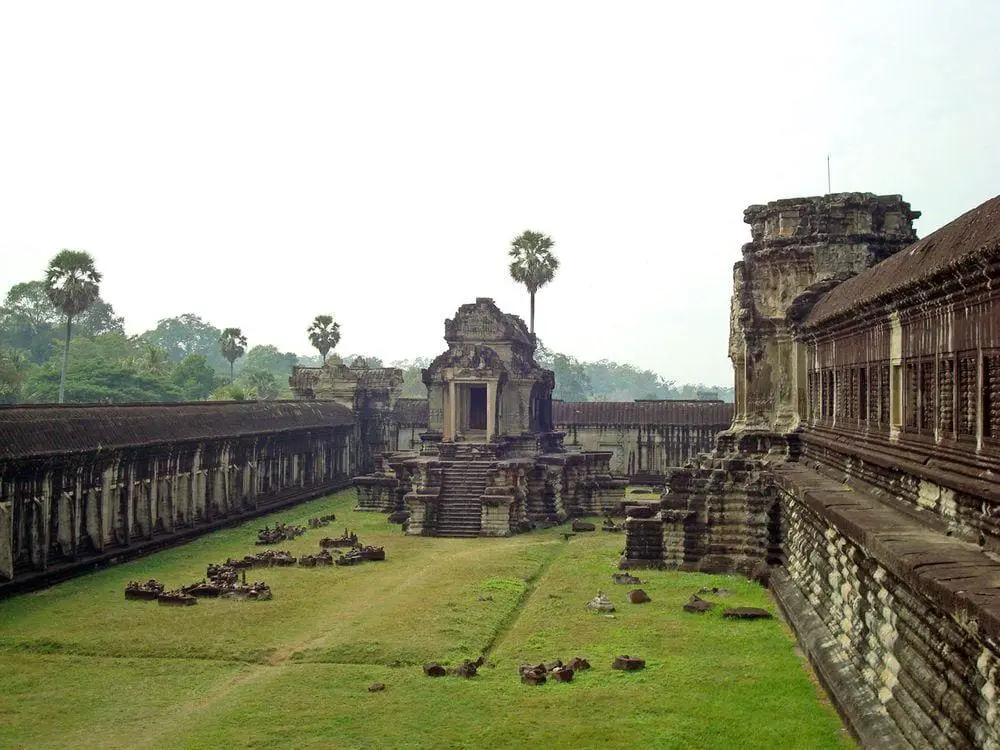
He came to rule a weakening empire and managed to turn it into well-run empire with successful army and a frenzy of construction activities of unseen ambition and quality.
The reign of Suryavarman II marks the golden time of Khmer architecture and its highest achievement – Angkor Wat.
Angkor Wat was built as the central shrine of the empire but some art historians consider that it was built also as the potential mausoleum for Suryavarman II himself.
Medieval history
Construction of this architectonic miracle most likely ended shortly after the death of the king. Bas-reliefs were not entirely finished by this time and works were continued much later, when the unique skills were lost and quality was considerably worse. The original name of the temple is not known.
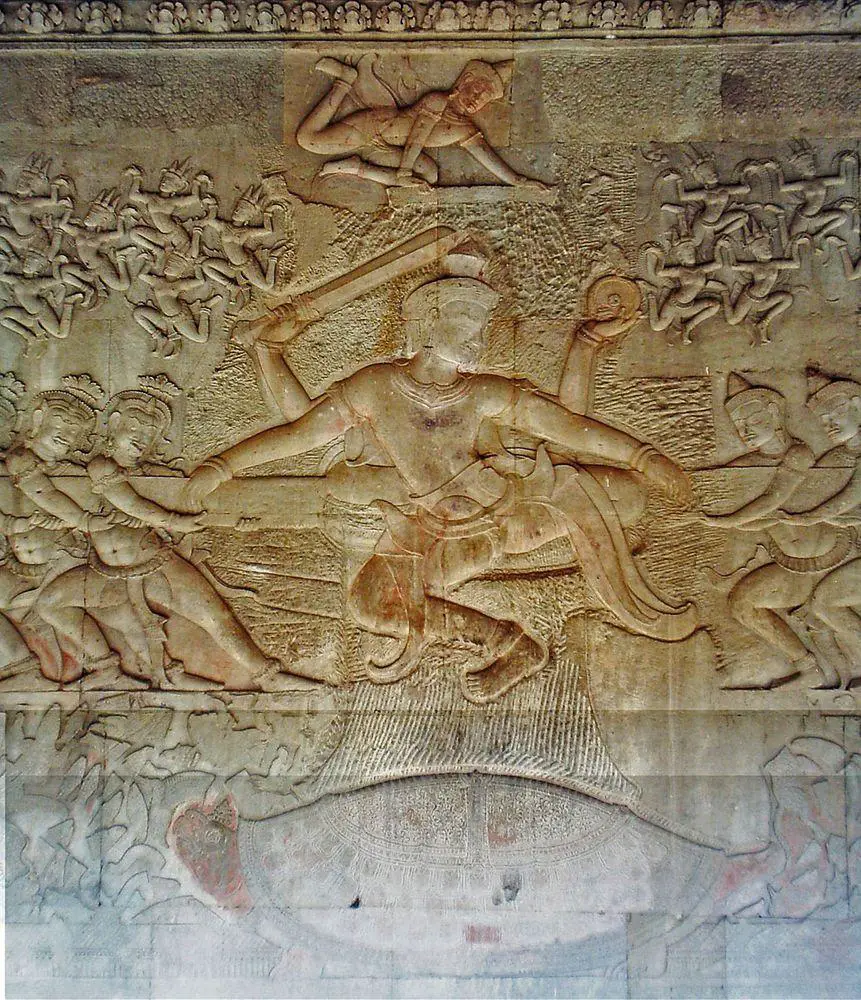
In 1177 Angkor was taken by Cham forces but later Khmer empire was restored by king Jayavarman VII. He restored the capital some kilometres further north from Angkor Wat.
In the 13th century Angkor Wat became Theravada Buddhist temple and this is Buddhist temple up to this day.
Angkor Wat was never completely abandoned. Its buildings were somewhat better preserved thanks to moats around it which prevented spread of forest.
Few centuries after its construction Angkor Wat turned into major pilgrimage site, piligrims came here from distant Asian countries. Portuguese António da Madalena visited the temple in 1586 and was stunned by its beauty: "…it is like no other building in the world."
Siamese (Thai) controlled Siem Reap and Angkor since the 14th or 15th century and this land was retaken by French only in the late 19th century and since then has constituted a part of Cambodia.
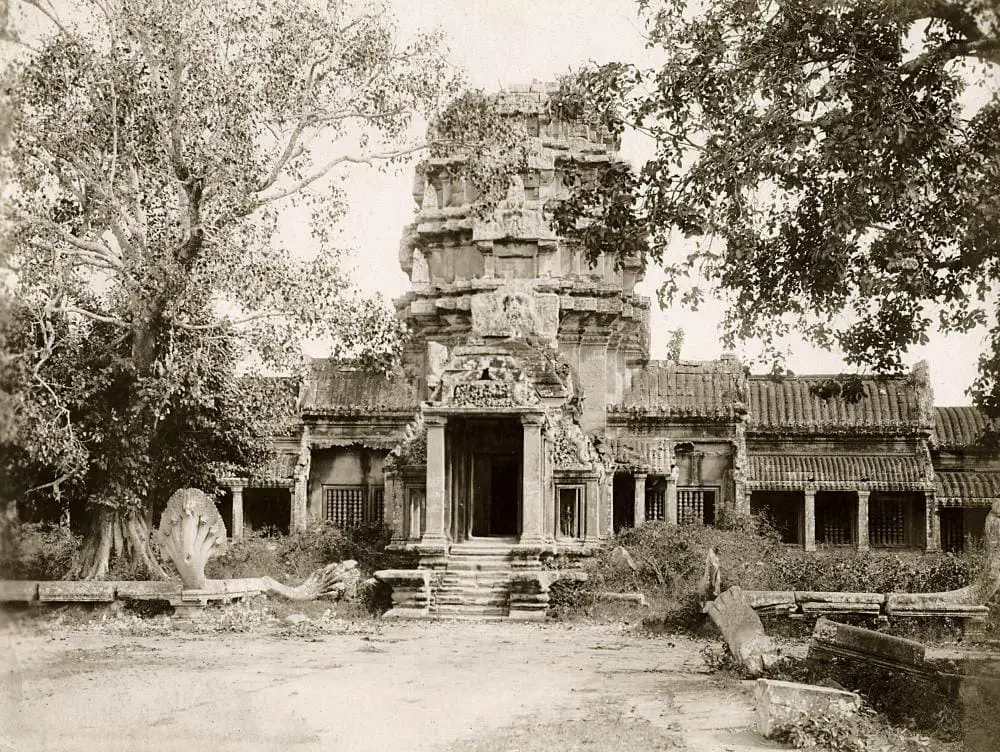
Angkor Wat gained wider recognition in the Western world in the middle of the 19th century after it was visited and described by the French explorer Henri Mouhot.
The 20th – 21st century
Angkor Wat has become a national monument of Cambodia and is a source of great national pride. This is the only existing building that is depicted on the national flag (since the introduction of the flag around 1863).
This is the best-preserved temple in Angkor but nevertheless there were needed large-scale restoration works.
During the 20th century Angkor Wat was largely restored – there was removed forest and ground over it. Now, as the political situation stabilizes, more and more tourists come. It is assessed that approximately one-half of tourists coming to Cambodia visit Angkor Wat.
References
- Angkor Wat, translation of Maurice Glaize’s popular and definitive 1944 guide to the Angkor Monuments, accessed in the 1st June 2014.
 Linked articles
Linked articles
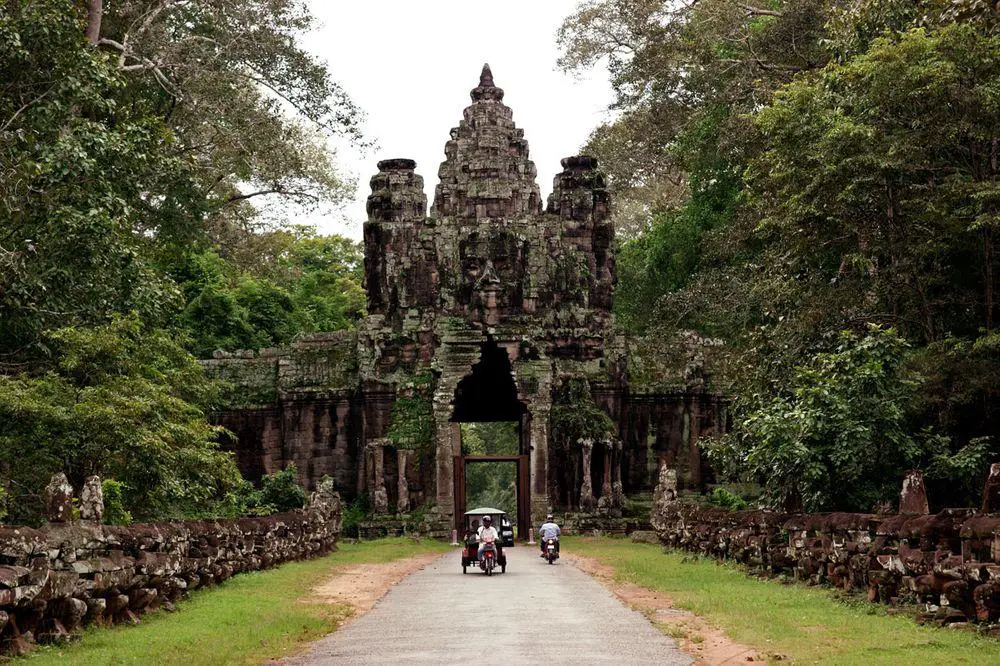
Wonders of Cambodia
In the 9th – 13th centuries the ancient Khmer Empire in present-day Cambodia experienced an unseen frenzy of creativity and ambitions. Now the whole world is amazed at the beauty of the world’s largest (and possibly – the world’s most ornate) temples in the ancient capital of the empire – Angkor. But Angkor by far is not alone – there are more sites including the recently discovered Mahendraparvata city.

Buddhist shrines
Buddhism is one of the world religions and at the same time is a spiritual philosophy with diverse traditions, beliefs, and practices. There exists a rich tradition of architecture expressed in Buddhist temples and monasteries.
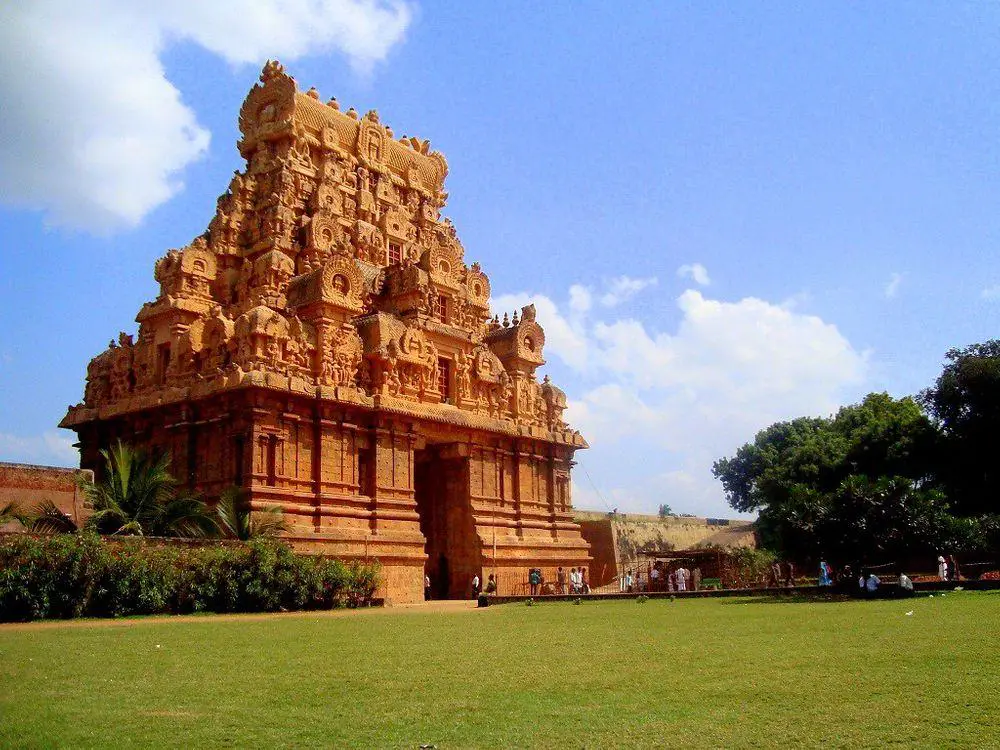
Hindu shrines
Hinduism is one of the oldest religions – possibly the oldest one among contemporary religions and Hindu temples belong to the most impressive religious buildings in the world.
 Recommended books
Recommended books
Guide to the Temples of Angkor
Angkor — the capital of the Khmer empire that thrived for 500 years from 802-1327 — is one of the most magnificent sites in Southeast Asia. The ancient city’s temples inspire with their innovative architectural designs, world-class narrative reliefs, and Hindu-Buddhist iconography. Still infused with their historical magic, they are yours to discover.
Angkor Wat: 20 Must see temples
Angkor Wat: 20 Temples is your passport to discovering the top 20 temples to see when visiting Angkor Wat. With the most relevant, up-to-date advice on which temples to see or skip, what visiting times are best for each temple, an amazing visit with hidden discoveries awaits you.

